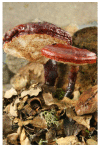Use of Ganoderma lucidum (Ganodermataceae, Basidiomycota) as Radioprotector
- PMID: 32325828
- PMCID: PMC7230513
- DOI: 10.3390/nu12041143
Use of Ganoderma lucidum (Ganodermataceae, Basidiomycota) as Radioprotector
Abstract
For millennia, naturopaths and physicians have used Ganoderma lucidum (reishi mushroom) for its diverse therapeutic properties, as recorded in the oldest Chinese herbal encyclopedia. Indeed, a radioprotective effect has been reported in the isolated components of its extracts. A systematic review and meta-analyses (PRISMA) was conducted in March 2020, searching databases including PubMed, Scopus, Embase, and Google Scholar, along with Clinical Trials. The inclusion criteria were ex vivo, in vitro, and in vivo studies, with full texts in English, conducted to determine the radioprotective benefits of G. lucidum, or reports in which ionizing radiation was used. From a total number of 1109 records identified, 15 full text articles were eligible, none of them were clinical trials. In vivo studies reveal the efficiency of G. lucidum aqueous extracts of polysaccharides and triterpenes in mice exposed to γ-rays. In plasmid, they can reduce radiation damage as an increment of the open circular form, as well as increase the DNA extension, as shown in vitro studies. Ex vivo studies conducted in human blood cells show the radioprotective effect of β-glucan of aqueous extract of G. lucidum, nevertheless, its implementation as radioprotector to humans is in need of further clinical research studies.
Keywords: Ganoderma lucidum; ex vivo; in vitro; in vivo; radioprotector; reishi mushroom; review.
Conflict of interest statement
The authors declare no conflict of interest.
Figures


References
-
- Roumeguère C. Champignon rapportés en 1880 d’une excursion botanique en Egypte et en Palestine par M. William Barbay. Revue Mycologique Toulouse. 1881;3:23–25.
-
- Hapuarachchi K.K., Wen T.C., Deng C.Y., Kang J.C., Hyde K.D. Mycosphere essays 1: Taxonomic confusion in the Ganoderma lucidum species complex. Mycosphere. 2015;6:542–559. doi: 10.5943/mycosphere/6/5/4. - DOI
-
- Atienza V., Montoro A., Sebastiá N., Soriano J.M. Natural organisms with effect radioprotective. In: Soriano J.M., Montoro A., editors. The Latest Advances in Radioprotectors of Natural Origin. The Spanish Nuclear Safety Council; Madrid, Spain: 2013. pp. 115–205.
-
- Wachtel-Galor S., Yuen J., Buswell J.A., Benzie I.F. Ganoderma lucidum (Lingzhi or Reishi) In: Benzie I.F.F., Wachtel-Galor S., editors. Herbal Medicine: Biomolecular and Clinical Aspects. 2nd ed. CRC Press/Taylor & Francis; Boca Ratón, FL, USA: 2011. pp. 175–200.
-
- Gu G.G. Reprint of Shen Nong Ben Cao Jing (1844) Lanzhou University Press; Lanzhou, China: 2009.
Publication types
MeSH terms
Substances
LinkOut - more resources
Full Text Sources
Other Literature Sources
Medical

